Genetically Modified Pigs for Xenotransplantation of Vascularized Xenografts and Derivatives Thereof
a technology of vascularized xenografts and genetically modified pigs, which is applied in the field of genetically modified pigs for xenotransplantation of vascularized xenografts and derivatives thereof, can solve the problems of irreversible graft damage and loss, the supply of human organs and tissues for allotransplantation will never fully meet the population's needs, and the critical shortage of human organs, so as to reduce the risk of immune response response to a xenotransplantation of xenotransplantation and xenotransplantation and a technology of a pigs and pigs and pigs and a technology of a pigs and a xenotransplantation and a technology of a pigs and a a xenotransplantation a technology of a pigs and a technology of a vascularization of a pigs a pigs a pigs a pigs and a pigs' pigs' pigs' pigs' pigs' pigs' pigs' pigs' pigs' pigs' pigs' pigs' pigs
- Summary
- Abstract
- Description
- Claims
- Application Information
AI Technical Summary
Benefits of technology
Problems solved by technology
Method used
Image
Examples
example 1
Construction of Endothelial Specific Vectors for Production of Transgenic Pigs
[0338]Endothelium-specific expression provides a strategy to limit expression of bioactive transgenes that could have adverse effects if expressed ubiquitously. Two expression systems used (in this example) are the porcine ICAM-2 promoter / enhancer system and the mouse Tie-2 promoter / enhancer system.
[0339]Examples of anticoagulant transgenes expressed via these endothelial specific vector systems include:[0340]1. human CD39 (vector pREV859B, which utilizes the Tie-2 promoter / enhancer and vector pREV861 which utilizes the ICAM-2 promoter / enhancer),[0341]2. human thrombomodulin (vector pREV872, which utilizes the ICAM-2 promoter / enhancer),[0342]3. human endothelial protein C receptor (vector pREV873, which utilizes the ICAM-2 promoter / enhancer),[0343]4. human tissue factor pathway inhibitor (vector pREV871, which utilizes the ICAM-2 promoter / enhancer).
[0344]All of these transgenes encode proteins that can inh...
example 2
Cell Line Preparation for Nuclear Transfer
Isolation of Cell Lines:
[0351]One cell line (183-6-6) was used as the genetic background for transfections to add the additional transgenes, and ultimately for nuclear transfer to generate pigs. This cell lines was produced by breeding of GTKO pigs (Dai et al., (2002) Nature biotechnology 20, 251-255; Phelps et al., Science, (2003) 299:411-414) with ubiquitously expressing hCD46 transgenic pig lines (Loveland et al., Xenotransplantation, 2004, 11:171:183). The 186-6-6 cell line was confirmed by genotype and phenotype as homozygous GTKO and hCD46 transgenic. The cells were prepared for use in NT as follows: A fetal fibroblast cell line was isolated from fetus 183-6-6 at day 36 of gestation. The Fetus was mashed through a 60-mesh metal screen using curved surgical forceps slowly so as not to generate excessive heat. The cell suspension was then pelleted and resuspended in DMEM containing 20% fetal calf serum and Antibiotic-Antimycotic (Invitro...
example 3
Production of Multi-Transgenic Pigs by Nuclear Transfer (NT)
[0357]Various methods can be used to produce the multi-transgenic pigs of the current invention. The following is one example in which donor cells used (line 227-3 and line 183-6-6) were the genetic background homozygous GTKO (lacked any function αGT) and were also transgenic for CD46. Donor cells were transfected, selected and screened positive for the pREV859B, pREV861, pREV872, and / or pREV873 vectors, as described in Example 2, prior to being used for NT. In some cases, multiple colonies of transfected and selected cells, all screening positive for the transgene(s), were pooled together prior to their use in NT.
[0358]Donor cells (fetal or adult fibroblast cells) for NT were cultured in Dulbecco's Modified Eagle Medium (DMEM, Gibco, cat#11995-065) supplemented with 10-20% fetal calf serum and 0-4 ng / ml basic fibroblast growth factor, in a humidified incubator at 5% O2, 5% CO2 balanced with nitrogen at 37° C. For culture, ...
PUM
| Property | Measurement | Unit |
|---|---|---|
| diameter | aaaaa | aaaaa |
| diameter | aaaaa | aaaaa |
| time | aaaaa | aaaaa |
Abstract
Description
Claims
Application Information
 Login to View More
Login to View More - R&D
- Intellectual Property
- Life Sciences
- Materials
- Tech Scout
- Unparalleled Data Quality
- Higher Quality Content
- 60% Fewer Hallucinations
Browse by: Latest US Patents, China's latest patents, Technical Efficacy Thesaurus, Application Domain, Technology Topic, Popular Technical Reports.
© 2025 PatSnap. All rights reserved.Legal|Privacy policy|Modern Slavery Act Transparency Statement|Sitemap|About US| Contact US: help@patsnap.com



